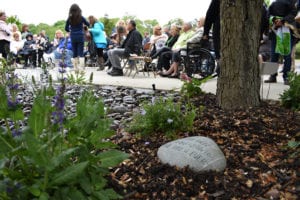By Victoria Espinoza
The latest production at the John W. Engeman Theater will have you dancing and singing — rain or shine. “Singin’ in the Rain” premiered this past weekend to a full house and one of the most energetic crowds in past years.
The classic movie, which is regarded as one of the greatest movie musicals of all time, comes to life as soon as the curtain rises, bringing the glitz and glamour of Hollywood’s golden age to Northport. It’s 1927 and Don Lockwood and Lina Lamont are the toast of Tinseltown until silent films are threatened with the rise of talking pictures. The Northport stage is set to look like an old Hollywood film studio lot. David Arsenault, the set designer, creates a simple but inviting backdrop, and many times throughout the show the sets are used to enhance musical numbers and bring even more laughs to the audience.

While the songs, actors and sets all excel in this production, the choreography comes out on top. Drew Humphrey is both the director and choreographer for this show and brings audiences a nonstop party with intricate and joyful dance numbers that were accompanied by nonstop applause throughout the night. Standouts include “Fit as a Fiddle,” “Make Em Laugh,” “Good Morning” and, of course, the timeless classic, “Singin’ in the Rain.”
Danny Gardner, who plays Don Lockwood, brings all the magic of Gene Kelly’s iconic scene with his mile-long grin, infatuated attitude and love-struck dance moves. Perhaps the most excited the audience got was when the rain started to pour on stage and Gardner appeared in a fedora with an umbrella under his arm.
Tessa Grady and Brian Shepard round out the main trio as Kathy Selden and Cosmo Brown, respectively, and the chemistry between the three is great fun to watch. Shepard brings the biggest smiles to audiences’ faces with fun jokes and a charming and lovable attitude. He steals the scene in “Moses Supposes,” and you can’t help but look for him in every scene to see what fun little moments he brings to his character. All three stars have beautiful voices, and Grady does a great job bringing her talents to Kathy Selden to make her a confident, charming character with some great comedic moments as well.

Of course, the other character who delighted audiences with laughs was Lina Lamont, played by Emily Stockdale. The voice she was able to achieve for Lamont was impressive and hilarious and her short solo number in the second act was sharp and enjoyable. She brought great depth to what could’ve been a one-dimensional character.
An extra fun treat for audiences was the short films inside the musical. Producer Richard Dolce and Humphrey do a great job making the film shorts hilarious, and as an added bonus a recognizable spot, Northport Village Park, makes a cameo appearance. It makes the black-and-white shorts twice the fun when you see the recognizable white gazebo as a backdrop for a sword fight and a lovers reunion. The ensemble cast who are a part of these shorts also deserve a special shout out for the delight they bring to the small screen.
Musical Director Jonathan Brenner handles the numbers wonderfully, bringing all the right emotion each scene calls for. “Moses Supposes” excels not only for Shepard’s lovable conviction but also the way Brenner handles the music. The same can be said for “Good Morning.” This scene delivers on all the fun the original film brings, and although the characters aren’t trotting together from room to room, this production’s version encapsulates all the charm.
And even with all the fun, this production saves the best for last with a closing number you won’t want to miss. Kurt Alger, costume designer for the show, adds an extra pop with costume choices for the end, bringing extra color and fun to the stage. But, of course, the elegant period pieces in the show’s entirety are also a marvel to see, especially a French-style costume worn by Stockdale.
With more than just fan favorite songs, this musical promises to deliver a fun-filled evening for all who attend.
The John W. Engeman Theater, 250 Main St., Northport will present “Singin’ in the Rain” through July 1. Tickets range from $73 to $78. To order, call 631-261-2900 or visit www.engemantheater.com.
Photos by Michael DeCristofaro

















